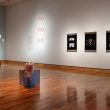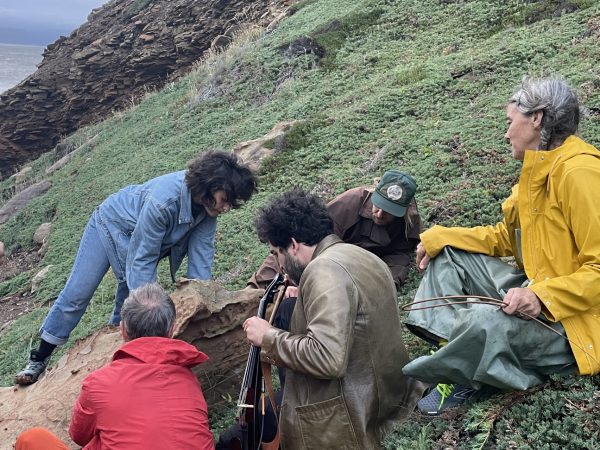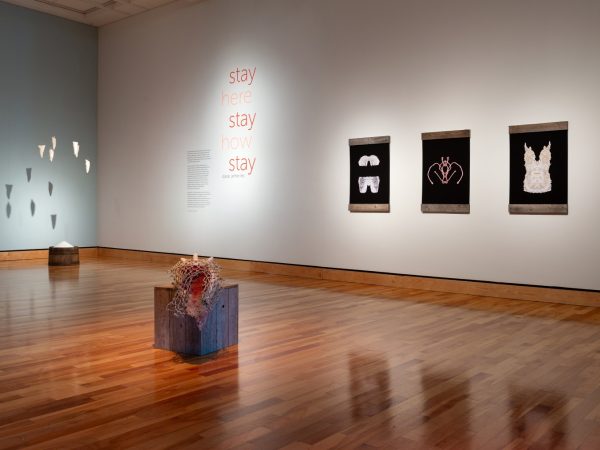In his groundbreaking work of theory and criticism, The Black Atlantic, Paul Gilroy writes of the “creolisation, metissage, mestizaje, and hybridity” that make up the modern world in order to argue that “the history of the Black Atlantic…continually crisscrossed by the movements of Black people—not only as commodities but engaged in various struggles towards emancipation, autonomy, and citizenship—provides a means to re-examine the problems of nationality, location, identity, and historical memory.” By thinking in terms of the Black Atlantic, Gilroy argues, we can better understand the African diaspora as a complex, interconnected, and mutually informing system that is affected by but not limited to national contexts. Beyond that, it can help us to better see the contradictions and fictions of absolutist ideas about nation, race, and identity more broadly.
It is incredibly fitting, then, that As We Rise, a photography exhibition I had the pleasure of seeing at the Dalhousie Art Gallery, has the subtitle: Photography from the Black Atlantic. The exhibition is made up of selections from the Wedge Collection. Established in Toronto in 1997 by Dr. Kenneth Montague, this collection gathers art from across the Black world and champions Black artists. By invoking Gilroy’s famous formulation, the exhibition foregrounds the diversity and the connections that characterize the African diaspora, as well as the powerful drive among Black artists to take control of how Black people, their bodies, their practices, and their identities are represented in visual media.
As We Rise contains pieces by over seventy artists, includes works by internationally known figures like Kehinde Wiley, famously the portrait maker of the Obamas, and celebrated African American photographer Carrie Mae Weems. It also includes more locally known and up-and-coming photographers, including a delightful number of Toronto-based artists such as Anique Jordan and Jalani Morgan. The youngest photographer whose work is featured was born in 1996, a full 110 years after the birth of the eldest in 1886. In this more-than-century scope, there are photographs from West, South, North, and Central Africa, the Caribbean, Brazil, Canada, the United States, and Europe, a veritable encircling of the Black Atlantic.
I was thrilled by this bringing together of the familiar and the unfamiliar. Still mesmerized by a beautifully executed photo by Malick Sidibé of a woman and man dancing politely in Mali, I was shocked and delighted to turn to a series of party photos that I immediately recognized as home. I was proven right when I saw that the playful and outrageous images by Tayo Yannick Anton were taken at Yes Yes Y’all, a series of queer hip hop parties that my friends and I used to attend in the mid-2010s.
Within the necessary limits of a single exhibition, As We Rise does a breathtaking job of gathering together diverse visions of Blackness across time and space. While the images themselves are deeply compelling, the work of the curator, Elliott Ramsey of the Polygon Gallery, adds additional layers of meaning and connection through the pieces’ placement in relation to one another. This curatorial practice is what allows the overarching theme of Black art as an avenue of self-determination to emerge.
The way that As We Rise demonstrates this will toward self-definition and self-representation is, for me, what makes this exhibition not merely pleasurable but electric, inspiring, and resonant. In the wake of the transatlantic slave trade, the inciting incident of the Black Atlantic, Black bodies have been subject to the representational whims of systems built decidedly against Black people’s best interest. Black artists respond to this context in myriad ways and are often consciously making aesthetic choices to resist it. The sheer range and creativity of this resistance is part of what makes this exhibition so powerful.
Many of the photographs play with intimacy, some revealing and others withholding. A young man full of swagger on a New York street looks directly into the camera, demanding that the viewer acknowledge his flyness; an artist photographs themself sitting naked and curled up on their apartment floor, arms covering their face. Some of the photos invite the viewer into intimacy with them while others keep the viewer at arm’s length. A father holds his son tenderly in their home; a face and body are blurry from movement, impossible to pin down. Several photos are decidedly defiant. In “Moffie in Irma’s Garden” by Jody Brand, the gender nonconforming subject lies languidly and proudly amidst nature; in a photograph by Jalani Morgan, Black Lives Matter protestors stage a die-in at Yonge-Dundas Square in downtown Toronto. The layout of the exhibition also facilitates moments of beautiful confluence across space and time: on one wall, three photos depicting images of glamour drawing together Bamako, London, and Vancouver. On another wall, a gorgeous photo of two Malian women astride a scooter hangs next to a charming Mississippi couple poised to take off on a motorcycle. It is both the sameness and the difference in these images that makes their proximity so compelling.
As We Rise is an incredible achievement. As both a representation of creativity as wide and as deep as the Atlantic and a source of inspiration for viewers, whether or not they are artists, to celebrate and insist on Black self-definition, this exhibition is a triumph.
















Leave a Reply